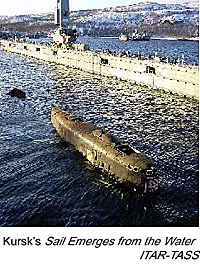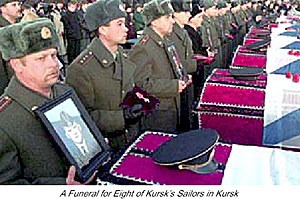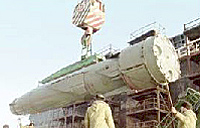 On Oct 8, 2001, Kursk emerged from the Barents Sea for the first time
since her loss August 12, 2000. It was not the kind of return anyone wished
for, but the Russian government and people were determined to bring the
massive submarine and her crew home.
On Oct 8, 2001, Kursk emerged from the Barents Sea for the first time
since her loss August 12, 2000. It was not the kind of return anyone wished
for, but the Russian government and people were determined to bring the
massive submarine and her crew home.
The Giant-4 barge arrived at Roslyakovo, near Murmansk, two days later with the sub’s hull suspended underneath. In addition to recovering the bodies of her sailors, the Russian navy searched the wreck for clues to the cause of the disaster.
So What Really Happened?
Even the Russians now agree it was an explosion triggered by a weapon the sub was preparing to launch. Admiral Kuroyedov, commander-in-chief of the Russian navy, described it as using hydrogen peroxide for fuel, which would make it a Type 65-76 torpedo, the only weapon with that propulsion system. It uses 1.5 tons of the stuff as oxidizer, with kerosine for fuel. He also announced it was being withdrawn from service.
The blast tore open the first four compartments, flooding the hull and taking her to the bottom.
What about the Crew?
 Out of the 118 crew and civilians aboard, 109 sets of remains have been
identified. The other remains are so fragmented that identification will be
extremely difficult. Some of the crew have already been buried at Serafimov
cemetery in St. Petersburg. A special memorial there will be dedicated to the
crewmen whose remains have not been identified.
Out of the 118 crew and civilians aboard, 109 sets of remains have been
identified. The other remains are so fragmented that identification will be
extremely difficult. Some of the crew have already been buried at Serafimov
cemetery in St. Petersburg. A special memorial there will be dedicated to the
crewmen whose remains have not been identified.
Unfortunately, my analysis of the accident in the April 2001 issue was wrong. At this time, I proposed (hoped) that the crew had died quickly, “probably almost immediately,” as a result of the massive explosion. It turns out that Russian subs are built tough, and that the after compartments held air. At least 30 men survived back there, in frozen darkness, for as long as eight hours, and possibly longer. It’s a risk every submariner accepts ever time they submerge, and makes me glad I was in the surface navy.
What Happens to Kursk Now?
There was never any hope of returning her to service, even if the Russians had the money to repair her. She presents a hellacious disposal problem.
 Unloading one of Kursk’s Granit [SS-N-19 Shipwreck] missiles.
Unloading one of Kursk’s Granit [SS-N-19 Shipwreck] missiles.
In addition to her nuclear reactors, she was carrying 22 P-700 Granit [SS-N-19 Shipwreck] warshots, one exercise missile, and an unknown number of torpedoes, all warshots. Some of these weapons were removed from the hulk by EOD personnel, but seven of the Granit missiles are trapped in their launch tubes by the distortion of the hull. They will be cut out of the sub’s hull along with their containers before the rest of the sub is scrapped. The reactor vessels held (another validation of Russian engineering) and will be defueled and disposed of on land.
What’s Left to Do?
Kursk was transported to the erpa shipyard for scrapping on 27 April. The Russian Navy now plans to raise the bow in June 2002. It’s already a mess, so it will be cut up in place in the seabed and brought up in pieces. As the site of the disaster, the Russians hope that the bow will provide the final pieces, allowing them to find the exact cause of the disaster. Don’t wait for them to share the data.
President Putin did a little housecleaning in December of 2001. Citing serious flaws at all levels of the command structure, he fired four and demoted ten senior admirals, virtually the entire staff of the Northern Fleet. Intended to cover both the faults that caused the accident and the ineffective “rescue” afterward, it will allow Putin to put his own people in the Northern Fleet command. Whether that improves the Navy is problematical, as long as funds remain at starvation levels.
BT
Back to The Naval Sitrep #22 Table of Contents
Back to Naval Sitrep List of Issues
Back to MagWeb Master Magazine List
© Copyright 2002 by Larry Bond and Clash of Arms.
This article appears in MagWeb (Magazine Web) on the Internet World Wide Web.
Other military history and related articles are available at http://www.magweb.com